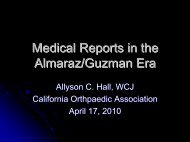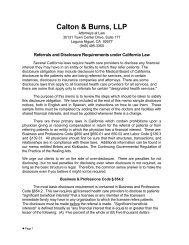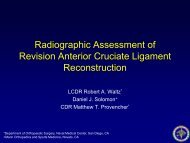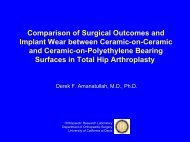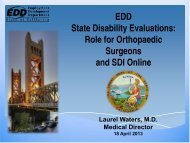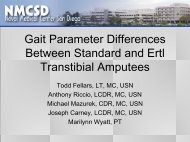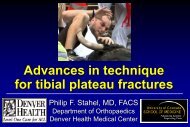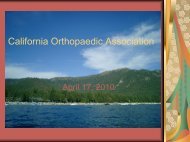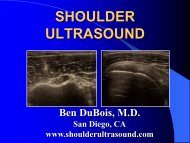Enhancing Your Practice's Revenue - California Orthopaedic ...
Enhancing Your Practice's Revenue - California Orthopaedic ...
Enhancing Your Practice's Revenue - California Orthopaedic ...
- No tags were found...
You also want an ePaper? Increase the reach of your titles
YUMPU automatically turns print PDFs into web optimized ePapers that Google loves.
• Have we met all current regulatory requirements to avoidStark and anti-kickback issues?• Can we afford the investment required to renovate spaceand purchase equipment?• Do we have sufficient capital to fund the startup of anew provider?• Do any of our insurance contracts prevent us frombilling for therapy services?Political ConsiderationsPerhaps the most important and often overlookedconsiderations pertain to political issues. The additionof PT/OT potentially jeopardizes existing relationshipswith existing PT/OT clinics, hospitals that offer PT/OTservices, primary care physicians, and even the broadercommunity. Serious discussion as to who may (or will)experience a negative financial impact if PT/OT is addedmust take place. <strong>Orthopaedic</strong> clinics would be naive tobelieve that there are no potential threats to relationshipsby developing POPTS, but each clinic’s situation is uniqueand the risk/reward trade-off must be evaluated carefully.Political Questions to Ask:• Which of our existing relationships may be harmed withthe addition of PT/OT?• Do we potentially lose any of our referral sources?• Are any of our hospital relationships at risk?• Will our local community support us in adding theselines of service?Benefits of Adding PTWhile there are many potential pitfalls to adding PT/OTlines of service to an orthopaedic practice, there are alsonumerous benefits. Naturally, one of the primary benefitsis financial. Profit in excess of $100,000 per therapist peryear is not unreasonable, and in many areas of the countrythe potential upside is even greater. Current MGMA data(2010 Report; 2009 Data) indicates mean collections are$235000 for PT and $199,000 for OT, with an averageprofit nearly $160,000. Although potential diminishingreturns limit how many therapists a clinic may hire,these additional revenues cannot be ignored in an era ofdeclining physician reimbursement. Next to ASCs, therapyis often the most profitable ancillary tool orthopaedicsurgeons wield. See Chapter 5: Ambulatory SurgeryCenters.Moreover, in-house therapy yields greater control overthe quality of therapy and improved continuity of care.With the physicians employing the therapists directly, thereis a greatly likelihood of patients receiving the treatmentsthe doctor expects. Being able to walk a patient down thehall and introduce him or her directly to the therapist whowill be providing treatment is a great way to extend thepatient relationship the physician has already established.Furthermore, patients are increasingly demanding convenience,and a “one-stop-shop” model for all treatments isbecoming the expected norm.Therapists can also be used as an additional marketingtool through community outreach and education. Injuryprevention training or rehabilitation education can generategoodwill among the community in general and the practice’sexisting patient pool in particular. Conducting ACLinjury prevention sessions is just one example of how atherapist can also be used as an additional marketing agentfor a practice.ConclusionWhile there are many potential operational, financial andpolitical risks and pitfalls to consider pertaining to POPTS,an orthopaedic clinic would be remiss in not thoroughlyevaluating such an important line of service. It seemshighly likely that PT/OT will not be as profitable in futureyears as it is now if continued reimbursement cuts focuson rehabilitation services. However, the increased patientsatisfaction and convenience may well outweigh any futuredeclines in reimbursement. There are many valid reasonswhy an orthopaedic clinic may choose not to bring PT/OT in-house, but the potential benefits should not beunderestimated. PT/OT services remain one of the mostprofitable ancillary tools available to orthopaedic surgeons,and the additional benefit and convenience for patientsmakes it a natural fit for many clinics.Contact: Michael Freehill, MD:michael.freehill@allina.comWilliam Evans, MBA: william.evans@allina.comChapter 4Urgent Care CentersBy Thomas Grogan, MDIn today’s challenging orthopaedic practice environment,increasing revenue and managing expenses are the keysto a successful practice. It is worth noting though, that“managing expenses” is not the same thing as “decreasingexpenses;” if an added expense generates revenue that morethan offsets the expense, it serves to increase the practice’sbottom line. Many physicians fail to understand this reality(they want to operate “lean and mean”) – sometimes totheir ultimate financial detriment.Since an orthopaedist’s time is limited, revenue generationby developing ancillary income is becomingincreasingly critical to maintaining the bottom line. Thedefinition of ancillary income is “money earned by an© 2011 American Academy of <strong>Orthopaedic</strong> Surgeons15




